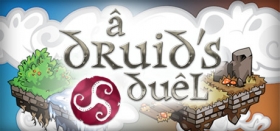
A Druid's Duel Preview
A Druid’s Duel is one of those fairly normal tile chessboard style games that bears a strong resemblance to Risk. Any fans of strategic battle games may find some interesting twists to their favorite genre when looking at this game. While the maps are grid-based like most in this genre, you are in for a surprise as a sure win can easily turn into you getting destroyed by the enemy. You have four different types of druids to utilise in your army and each has their own unique set of skills and the ability to transform into an animal.

The Guardian is a druid who is mainly used for movement, much like a pawn in chess. He is capable of turning into a wolf to claim unoccupied spaces on the board; however his movement makes him very susceptible to being singled out and killed. The SnarlClaw is a druid who uses a hammer to wipe both enemies and obstacles from the board who also transforms into a bear that is capable of killing multiple enemies with ease. The WindRider is a mobile archer who can either choose to shoot down enemies from afar, or transform into an eagle and move far across the board or instantly destroy an enemy druid. The last druid, the WayWalker, is in essence a heavy crowd control type of druid who can create obstacles on the map, and when he turns into a turtle can block your units from being attacked.

The objective of the game is to capture all of the pieces of land until your enemy has none, much like Risk. For each piece of land you own, you receive bonus energy at the beginning of your turn. This energy can either be used to summon druids or have your current druid transform into an animal to destroy enemies or control the board. To own a piece of land your druids only have to walk on it and are not required to stand on the tile, however leaving pieces of land unoccupied can have disastrous results as your enemy can walk across all of your tiles and leave you stranded with no resources.
The map is a maze in itself as there are certain obstacles that will stop you from obtaining that essential piece of land that will give you the advantage. Sometimes you will be required to spend resources on a bridge to close a gap between two pieces of land, or a rock will have to be smashed by a SnarlClaw. These choices can mean the difference between an easy win and a gritty fight to the end.
Some of the spaces in the game are also more valuable in resources than others, and this can have a huge impact on how you decide to conquer the map. The map can consist of spaces that represent different seasons,which give different amount of mana. An example is the Deepwinter space, which only provide you with 1 mana for capturing them while Aldenfalle spaces will give you three mana and are therefore a much better option for capture.

While the spaces can be crucial in obtaining enough mana to win the game, they are not the only option for gaining resources. The map will also spawn in random fairies and capturing those spaces can give you a boost of between three and nine mana for the turn. While the capture of fairies is a temporary reward, the relics that are placed on the map can give you 10 extra mana crystals for each turn that you own it. This relic cannot be destroyed by the SnarlClaw and is therefore a very valuable asset.

Playing against the computer was fairly easy as it would make some careless mistakes, however you still have to be constantly aware of your enemies’ opportunities to capture pieces of land that you thought you would hold easily. It seemed like even with most tiles in my ownership, a match could be easily turned by a well-placed SnarlClaw who would demolish a group of druids I thought were safe.
While the game may sound easy enough to learn, it actually takes a decent amount of time to master every aspect of it to the point at which you will be ready to play against actual people.
The single player campaign consists of 50 maps that will assist in learning the rudimentary basics of the game and upon completing it, there is the online mode and local multiplayer to contend with. A feature that is very unique in this game is the ability to literally walk away from a match and pick it up later on, much like IOS games where you receive a notification that it is your turn and you may complete it at your leisure. While this may sound like a bad feature it actually made things interesting as you have the ability to have multiple games on the go.
The multiplayer did have a few problems that need some work, such as the lag in between a player’s turn. At times the game would seemingly lag for no apparent reason and sometimes the lag could last for up to a full minute. These things were not game breaking to me and just proved to be a minor inconvenience that I’m sure will be sorted out in the future.
Overall A Druid’s Duel was easy to learn and hard to master without hours of practice, however it was very enjoyable. The single player campaign was actually pleasurable to play through and did not grow old at all, which will prove a true asset in learning to play the game and conquer the board. Hopefully the lag with the multiplayer will be sorted out sometime soon, as I am looking forward to what else this game can offer.








COMMENTS